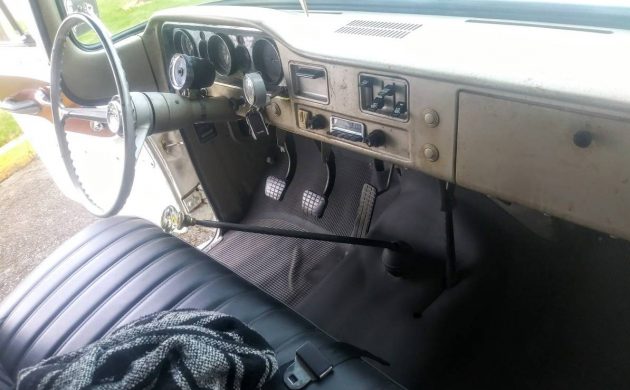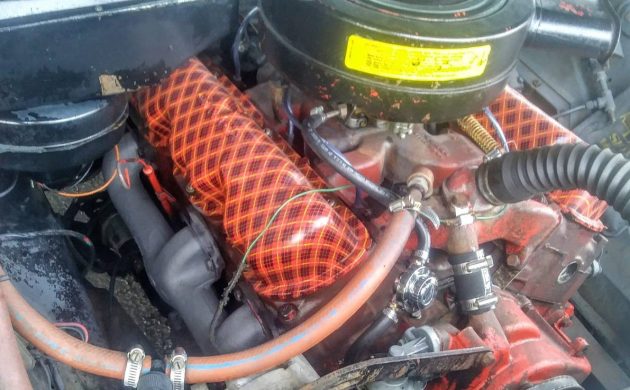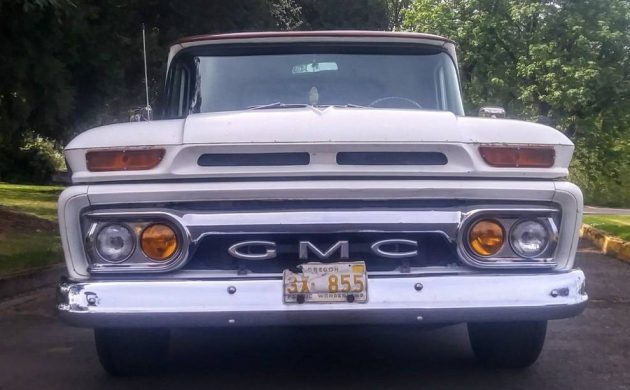Now I’ve heard it all – an auto engine with scotch plaid valve covers? Yup, it’s true – more on that to follow. In the interim, and for your review, we have a lowered 3/4 ton GMC truck from 1963, a year when Chevy and GMC trucks actually had differences. This interesting vehicle is located in Eugene, Oregon and is available, here on craigslist for $10,500. Thanks to Andria A for this tip!
There is quite an amalgam of effects going on here but nevertheless, it all pulls together. The exterior was painted in the ’80s and it’s a twenty-footer – looks OK at a distance but it’s far from perfect and as the seller states, “has been touched up, scratched, chipped, etc. over the decades, has a great patina ‘don’t worry about scratching it’ look“. There is something to be said for that! There are some visible imperfections in places but the chrome, stainless trim, and wheel covers all make up for any shortcomings the finish may possess. And the entire effect is pulled together by virtue of this truck’s slammed stance. This is definitely a drive-it and enjoy-it kind of vehicle!
Where things take a bit of a turn is the bed cap. You could call it “patina” but it looks more like a Liberian tanker with the rust streaming down the sides. While these were all the rage in the ’80s and ’90s, this item, with its jalousie side windows, looks more like 1963. So what’s inside? A cedar wood bed and not much else.
The standout item in the passenger compartment is that “diamond” doorknob standing in as a shifter knob on the four-speed manual transmission shift lever. I used to own a late 19th-century farmhouse that had quite a few of those adorning most of the interior doors. The seat cover, seat foam, and rubber floor mat are all new and look great. The interior steel surfaces, of which there are many, are painted in a typical ’60s “fawn” finish as found in GMC and Chevrolet trucks alike. The instrument panel has been enhanced with a tachometer and what looks like a clock to the far right side. What really caught my attention is the vacuum gauge occupying the left most gauge opening – anyone have an idea if that’s an original item? It looks too new for this truck but I know Chevrolet was using vacuum gauges in their full-size passenger cars in ’65 and ’66.
Now, back to the plaid valve covers. One place where GMC and Chevrolet trucks differed was in the engine room. Where GMC utilized V6 engines, in this case, a 165 gross HP, 305 CI powerplant, Chevrolet relied on their tried and true, in-line, six-cylinder engine. Research indicates that this plaid “accessory” was a one-year-only item and probably meant to convey “Scottish Thrift” as it related to the V6’s fuel economy. Here is a plaid valve cover link that references this unusual inclusion and suggests some potential reasons for their existence. Who knew?
This is a neat truck from an era that hasn’t completely caught on with collectors, yet, but interest in the ’60-’66 model year series is building steam. This GMC 2500 is a little difficult to button-hole into a specific category and that’s one of its more endearing qualities – not every automotive subject has to be neatly categorized, right?







Beautiful. But gone now
I just found out about the big block v6. Then I found out about the plaid valve covers. I don’t think they could have made an uglier design if they tried. As much as I like GM. Vehicles, I don’t think I could ever get used to them. I’m sure their valuable, only because they are rare. Certainly not because they are good looking.
No one has brought up the red heater hoses for a while so I thought I would kick that dog.
THat and the radiator system flush attachment…I used to do these with Atlas hoses at the Chevron dealer when I wore a younger mans clothes (skinnier)
I had a 1962 suburban ( GMC ) that had a v6 with plaid valve covers. It was a different plaid than pictured for this 63.
Wow, even the “Plaid” performance package Teslas don’t have plaid valve covers (Or plaid seats, which is harder to justify since they do actually have seats, but I digress).
While dead men don’t wear plaid, this truck certainly does.
Vacuum gauges were common on a lot of GM vehicles of the early 1960s. I recall seeing one on the GMC bus I rode to school. Back and forth the needle swung as the driver rowed the four-speed.
Now, the engine. A five liter six with modern controls would be a torque beast with those huge pistons. I guess that weight and cost considerations led GM to derive the 4.3 out of the 350.
+ 1 for referencing “Dead men” movie! A true unappreciated Steve Martin classic.
“Back and forth the needle swung as the driver rowed the four-speed” Lol!!
Since I was such a badass on the bus, I was always assigned to the front seat behind the driver (Miss Monteage), and I clearly remember watching the same vacuum needle on a 196* Ford B700 every day. If I remember correctly, there was also an amber light that came on every time that she was supposed to shift to the next gear.
And the common 305 v6 was the baby of the family. Those V6’s went up to 478 cubes. There was a 702 V12 that used 4 of the V6 heads. And a 687 V8 (60 degree)….
Just for the record, I heard from our good friend, Geomechs, the reason for the plain valve covers, was they had a lot of problems with the early motors, and to distinguish the replacement motors from original, they had plaid valve covers, like the link sez too. I don’t think it had anything to do with “the thriftiness of the Scots”,, that was done by Studebaker in the late 50’s( the Scotsman) and not sure the Scots cared for that. There are 2 V6’s I’d care about, these and the “Dauntless Jeep V6”, otherwise, I never cared for them. In my line of work, it was “6 in a row, makes ‘er go”.
Thanks for the comments, its been a fun build. The title states 150p, but this truck is a 3/4 ton and by early GMC is a 2500. The C series Chevrolets were C20
Yes, it was confusing as it was listed as a Chevrolet “C” series. I got the 3/4 ton part right but not the numerical designation. It has now been corrected.
Thx,
JO
Had a couple of those 305’s. Thrifty they were not.
Three-quarter ton designation in 1963 was 1500, as the half was 1000.
A 2500 was a full-ton. I used to have the sales brochure for a ’62 or ’63; no photos, all drawings.
I still have my 63 GMC with the plaid valve covers. Yes, it is a torque monster, so much so that the transmission, driveshaft and rear axle have all been replaced or rewelded.
This engine is the baby of the family. 351, 401, and 478 V6’s were also produced at this time; later on 332? and others were produced. Also in this family are the 637 V8 and the 702 V12. All were 60 degree low compression engines.
The engine in my truck is reasonably thrifty- about 12 city and 16 hwy mpg. Which is MUCH better than the F-250 390 which gets 7 mpg no matter what!